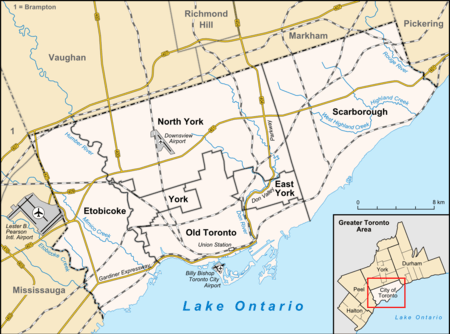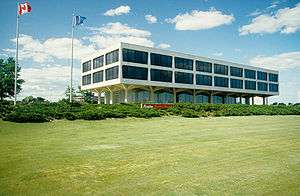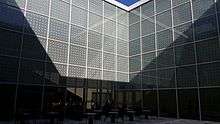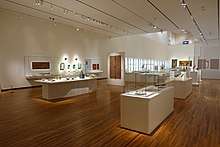Aga Khan Museum
The Aga Khan Museum (French: Musée Aga Khan) is a museum of Islamic art, Iranian (Persian) art and Muslim culture located at 77 Wynford Drive in the North York district of Toronto, Ontario, Canada.[1] The first museum in the western world dedicated to Islamic art and objects,[2] it houses more than 1,000 rare objects including artifacts from the private collections of His Highness the Aga Khan, the Institute of Ismaili Studies in London, and Prince and Princess Sadruddin Aga Khan. As an initiative of the Aga Khan Trust for Culture, an agency of the Aga Khan Development Network, the museum is dedicated to presenting an overview of the artistic, intellectual, and scientific contributions that Muslim civilizations have made to world heritage. The Museum’s mission is to foster a greater understanding and appreciation of the contribution that Muslim civilizations have made to world heritage. Through education, research, and collaboration, the Museum will foster dialogue and promote tolerance and mutual understanding among people. In addition to the Permanent Collection, the Aga Khan Museum features several temporary exhibitions each year that respond to current scholarship, emerging themes, and new artistic developments. The Museum Collection and exhibitions are complemented by educational programs and performing arts events.
Musée Aga Khan | |
 Exterior view of the Aga Khan Museum | |
 Location of the museum in Toronto | |
| Established | September 18, 2014 |
|---|---|
| Location | Toronto, Ontario, Canada |
| Coordinates | 43.725429°N 79.331997°W |
| Type | Muslim arts and culture |
| Collection size | 1,000 |
| Director | Henry Kim |
| Public transit access | |
| Website | www |
History
Development and construction

For many years, His Highness the Aga Khan, spiritual leader of Shia Ismaili Muslims, was planning to build a major museum for Islamic art and artifacts that aligned with the Ismaili community’s mission to offer new perspectives into Islamic civilizations by weaving together cross-cultural threads throughout history. The location in Don Mills, Toronto, Canada, was confirmed in 2002, after protests blocked a $60-million Canadian offer for a site on the River Thames across from the British Houses of Parliament.[3] The Aga Khan then chose Canada as a tribute to the country’s pluralism.[2]
The Aga Khan bought the former Bata Shoes Head Office, a building that was adjacent to the Ismaili Centre, which was already under construction. Designed by modernist architect John B. Parkin, the building was demolished in 2007 after it was determined to be unsuitable for the museum. The new structure was designed by Pritzker Prize winner Fumihiko Maki. It also shares the 6.8 hectare space with public gardens created by Lebanese landscape architect Vladimir Djurovic.
The foundation-laying ceremony for the project was performed by Canadian Prime Minister Stephen Harper and the Aga Khan on May 28, 2010.[4]
European tour
While a permanent home was being built for the collection, selected items went on tour in Europe. Exhibitions took place at the following institutions:
- Palazzo della Pilotta in Parma[5][6]
- Ismaili Centre in London[7]
- Louvre in Paris[8][9]
- Calouste Gulbenkian Museum in Lisbon[10]
- CaixaForum Madrid
- CaixaForum Barcelona[11]
- Martin-Gropius-Bau in Berlin[12]
- Sakıp Sabancı Museum in Istanbul[13]
- The Hermitage in St. Petersburg[14]
The exhibits received wide international acclaim.[7][15] The exhibit conveys both Dīn and Dunya, which can be translated as 'Spirit & Life' — the religious and secular aspects of life which are inextricably linked in Muslim cultures.[8] The first exhibitions were organized in two parts: The Word of God consisting of sacred texts and related objects and The Power of the Sovereign reflecting Muslim courts and their figures. More recent exhibitions have been organized as The Word of God and The Route of the Travellers showing the geographic breadth of the Islamic world.
Opening

The Aga Khan Museum was open to the public on September 18, 2014. Henry Kim served as the museum's first Director and CEO since 2012. Prince Amyn Aga Khan was appointed the new Chairman of the Board effective May 18, 2016. The role was previously held by his brother, the Aga Khan, who still maintains a close connection to the museum as the sole Member of the Organization.
In 2016, RGD InHouse Design presented the Award of Distinction to the Aga Khan Museum for the exhibition Home Ground: Contemporary Art from the Barjeel Art Foundation (July 25, 2015 - January 3, 2016).[16]
The Director of Collections and Public Programs, Dr. Ulrike Al-Khamis began her appointment on September 1, 2017. In 2017, the Aga Khan Museum Shop also launched an online shopping platform.[17] Most items online and onsite were commissioned exclusively for the Aga Khan Museum. In many instances, the items — jewellery, books, clothing, artwork, and more — are connected to the Aga Khan Museum’s temporary exhibitions as well as its Permanent Collection.
The Aga Khan Museum was recognized as one of the best museums in Toronto by Conde Nast Traveler in 2018.[18] In the same year, the Aga Khan Museum’s exhibition, The World of the Fatimids, received a Global Fine Art Award in the Ancient Art (BC – 1200) category, and an honourable mention in the Global Humanity category for the 2017 exhibition, Skate Girls of Kabul.[19] In June 2018, Sri Lankan-born chef Shen Ousmand launched a new menu at the Aga Khan Museum’s restaurant Diwan.[20] The McEwan Group, led by Chef Mark McEwan, has been at the helm of the Museum’s food services since 2016.
In 2021, Line 5 Eglinton, a new line that is part of the Toronto subway system will open an Aga Khan Park & Museum stop.
Architecture
.jpg)
Designed by Pritzker Prize-winning architect Fumihiko Maki, the Aga Khan Museum shares a 6.8-hectare (17-acre) site with Toronto’s Ismaili Centre, which was designed by Indian architect Charles Correa. The surrounding landscaped park was created by landscape architect Vladimir Djurovic and is a contemporary interpretation of the Islamic courtyard—the Charbaag.
The Museum is home to galleries, exhibition spaces, classrooms, a reference library, auditorium and restaurant. It houses a permanent collection of over 1,000 objects including rare masterpieces of broad range of artistic styles and materials representing more than ten centuries of human history and geographic area.
Commissioned by the Aga Khan, the museum building and the spaces around were designed to be seen as a celebration and mysteries of light. The rectilinear building is oriented forty-five degrees to solar north where all its sides are exposed to the sun. The form has been chiseled to create a concaved angular profile that is also a natural expression of the two level building. Clad in sandblasted white Brazilian granite, the surfaces of the building are set in motion in a constant interplay with the sun in light and deep shadows. The effect is similar to a sundial.[21]

Within the building, there’s a fully glazed courtyard intended as a permanent peaceful sanctuary. The courtyard’s glass walls are imprinted with a double-layered pattern that creates a three dimensional effect recalling the traditional Islamic Jali screens. The light from the courtyard moves patterned shadows on the soffits, walls and floor of the grand cloister. Up above on the second level, four large openings overlook the public spaces through a cast zinc screen in the form of a contemporary Musharabiya, an Islamic bay window. Within the galleries, large aluminum paneled skylights perforated with small hexagonal openings emit soft natural light into the exhibition areas.
Collection

The Aga Khan Museum is dedicated to the acquisition, preservation, display and interpretation of artifacts relating to the intellectual, cultural, artistic and religious traditions of Muslim communities, past and present. Artifacts include ceramics, metalwork, and paintings covering all periods of Islamic history. Manuscripts in the collection include the earliest known copy of Avicenna's Qanun fi'l-Tibb ("The Canon of Medicine") dated 1052.[8]
The museum will become a repository of historical materials related to the Ismaili community and house research programs related to each one of the aspects of its institutional mission. It will also provide a space for permanent exchanges between the Islamic and the Western worlds on educational, cultural and socio-economic issues.
The collection, which comprises some 1,000 objects,[22] includes several superb examples of Qur'an manuscripts that demonstrate the variety of script, media and decorative styles that evolved in the Muslim world. Among them, an eighth century North African folio demonstrates the earliest style of Kufic script written on parchment. A page from the well known Blue Qur'an provides an example of gold kufic script on indigo-dyed parchment. The Blue Qur'an is considered one of the most extraordinary Qur'an manuscripts ever created; its origins are 9th-tenth century North African, and it was likely created for the Fatimid caliphs ruling from Qayrawan.[8]
Located on the main floor of the museum, the Bellerive Room displays a selection from the ceramics collection of the late Prince Sadruddin Aga Khan and Princess Catherine Aga Khan. The room is a recreation of the “La Chambre Persane,” or “Persian Salon,” in their home, Château de Bellerive in Geneva, Switzerland, where part of the collection was originally on display. There are approximately 60 ceramic objects on view in the Bellerive room. They date from the early Islamic periods through to the 17th century. Their styles reflect the innovative technological and aesthetic contributions of Islamic potters through the ages, which were often in dialogue with influences from as far afield as China and Europe.
Selected temporary exhibitions
- Home Ground: Barjeel Art Foundation Modern Arab Art Collection (15 July 2015 - 3 January 2016)
- Abbas Kiarostami: Doors Without Keys (November 21, 2015 - March 28, 2016)
- Syria: A Living History (October 15, 2016 - February 26, 2017)
- Rebel, Jester, Mystic, Poet: Contemporary Persians (February 4, 2017 - June 4, 2017)
- Syrian Symphony: New Compositions in Sight and Sound (May 20, 2017 - August 13, 2017)
- Here: Locating Contemporary Canadian Artists (July 22, 2017 - January 7, 2018)
- The World of the Fatimids (March 10, 2018 - July 2, 2018)
- The Moon: Voyage Through Time (March 9, 2019 - August 18, 2019)
- Caravans of Gold, Fragments in Time: Art, Culture, and Exchange Across Medieval Saharan Africa (September 21, 2019 - February 23, 2020)
- Don’t Ask Me Where I’m From (February 25, 2020 - October 11, 2020)
- Sanctuary (March 21, 2020 - October 25, 2020)
The exhibition titled 'Don't Ask Me Where I'm From' is in partnership with Fondazione Imago Mundi.[23][24] The project channels the experiences of artists who are first, second, and third-generation immigrants–a growing body of people raised in a culture other than their parents–in a series of several works exploring cross-cultural artistic realities.[25]
The exhibition titled 'Sanctuary' showcases immigrants' experience using rugs as a medium to share narratives to demonstrate stories, histories, place, and purpose. The exhibition comprises the work of thirty-six artists from twenty-two countries creating rug designs. The designs were woven into the rugs by artisans in Lahore, using traditional techniques to create each piece of art. Artists of this exhibition include Ai Wei Wei.[26]
In popular culture
- The museum appeared in the Star Trek: Discovery episode "Lethe", where it was used as a filming location for scenes on the planet Vulcan.
- The scientific conference in the 2017 American science fiction comedy film Downsizing was filmed at the museum.
See also
References
- "New Aga Khan Museum To Showcase Cultural Contributions of Muslim Civilisations". Artlyst. Retrieved August 20, 2014.
- "Aga Khan Museum will prove to be of historic significance: Siddiqui | The Star". thestar.com. Retrieved April 8, 2019.
- "Aga Khan's museum thwarted by real-estate fight". Retrieved April 24, 2020.
- "Mawlana Hazar Imam is awarded Honorary Canadian Citizenship as he is joined by Prime Minister for Foundation Ceremony in Toronto". TheIsmaili.org. May 28, 2010. Archived from the original on June 1, 2010. Retrieved May 30, 2010.
- "Sacred Art and Music of the Muslim World in Parma, Italy" (Press release). Aga Khan Development Network. March 30, 2007. Archived from the original on April 19, 2007. Retrieved April 8, 2007.
- "Splendori a Corte". Archived from the original on May 24, 2007.
- Renzetti, Elizabeth (July 11, 2007). "A stunning debut for Toronto-bound Treasures of Islam". The Globe and Mail. Archived from the original on August 24, 2007. Retrieved December 2, 2007.
- Spirit & Life: Masterpieces of Islamic Art from the Aga Khan Museum Collection. Switzerland: The Aga Khan Trust for Culture. 2007. ISBN 978-2-940212-02-6.
- "Masterpieces of Islamic Art from the Aga Khan Museum". Louvre. Archived from the original on December 10, 2007. Retrieved December 2, 2007.
- "The Path of Princes: Masterpieces from the Aga Khan Museum Collection". Museu Calouste Gulbenkian. Archived from the original on March 19, 2008. Retrieved March 12, 2008.
- "Catorce siglos de arte islámico". masdearte.com. Retrieved March 31, 2010.
- "Treasures of the Aga Khan Museum, Masterpieces of Islamic Art Exhibition". Martin-Gropius-Bau. Archived from the original on February 18, 2010. Retrieved March 31, 2010.
- "Treasures of the Aga Khan Museum: Arts of the Book and Calligraphy". MSakıp Sabancı Museum. Archived from the original on January 23, 2011. Retrieved March 7, 2011.
- "Architecture in Islamic art: treasures of the collection of Aga Khan". The Hermitage. Archived from the original on May 14, 2011. Retrieved March 7, 2011.
- "Islamic treasures go on show in Italy". Middle East Online. March 24, 2007. Archived from the original on June 12, 2011. Retrieved December 2, 2007.
- "Award of Distinction: Aga Khan Museum - 'Home Ground' Contemporary Art from the Barjeel Art Foundation | RGD". www.rgd.ca. Retrieved April 17, 2019.
- "Modern-Day Gifts from the Silk Route are a Click Away" (PDF).
- Ramani, Sandra. "10 Best Museums in Toronto". Condé Nast Traveler. Retrieved April 8, 2019.
- "2018 Award Winners and Honorable Mentions ‹ Global Fine Art Awards". Retrieved April 8, 2019.
- Karamat, Amber (August 14, 2018). "Opinion | Aga Khan Museum welcomes Sri Lankan-born chef to Diwan Restaurant". Toronto.com. Retrieved April 8, 2019.
- "The Aga Khan Museum / Maki and Associates". ArchDaily. July 30, 2018. Retrieved April 8, 2019.
- Mehnaz Thawer (May 20, 2010). "Aga Khan Museum Collection reflects pluralism of the Muslim world and shared human heritage". TheIsmaili.org. Archived from the original on May 24, 2010. Retrieved May 24, 2010.
- Janjuha-Jivraj, Shaheena. "Italian Billionaire Luciano Benetton And The Aga Khan Museum Partner To Create Cultural Dialogues". Forbes. Retrieved December 7, 2019.
- Fox, Angelica (March 2, 2020). "Aga Khan Museum exhibitions delve into human migration". Toronto.com. Retrieved March 3, 2020.
- "Aga Khan Museum celebrates the creativity and artistic contributions of newcomers with a season focused on stories of immigration". www.abc-7.com. Retrieved February 28, 2020.
- Janjuha-Jivraj, Shaheena. "Re-Imaging Art In The Pandemic - The Aga Khan Museum Provides Sanctuary Virtually". Forbes. Retrieved August 5, 2020.
External links
| Wikimedia Commons has media related to Aga Khan Museum. |
- Official website
- "Aga Khan Park". Retrieved May 22, 2015.
- "Aga Khan Museum Online Gallery". Archived from the original on May 31, 2010. Retrieved May 31, 2010.
- "AKTC Museum Projects". Archived from the original on December 6, 2006. Retrieved November 29, 2006.
- "Aga Khan Trust for Culture". Archived from the original on November 28, 2006. Retrieved November 29, 2006.
- "Aga Khan Development Network". Archived from the original on November 30, 2006. Retrieved November 29, 2006.
- "TheIsmaili: Portuguese Jamat explores the Path of Princes". Archived from the original on September 7, 2008. Retrieved September 7, 2008.
- Aga Khan Museum on TOBuilt